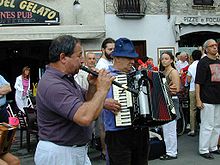Piffero
The piffero (also piffaro ) is a double reed instrument that is played in northern Italian folk music. It is the main instrument of traditional music in the Quattro Province , a region of the Ligurian Apennines north of Genoa , consisting of the four provinces of Pavia , Alessandria , Genoa and Piacenza . The instrument tuned to g¹ is a descendant of the medieval shawm . Related to the Piffero is the larger Bifora or Pifara native to Sicily .
Traditionally, the piffero is accompanied by the müsa , the bagpipes typical of the Apennines . In the early 20th century, the muesa was largely replaced by the accordion , which musicians found more versatile. Towards the end of the 20th century, however, the bagpipes made a comeback and the piffero is often accompanied by one or both of these instruments these days.
One of the few still active instrument makers is Ettore Losini , called “Bani”, in Degara di Bobbio .
Structure of the Piffero
- The mouthpiece (ital. Musotto ) consists of the pirouette , in which a conical brass tube with the sound-producing double reed is glued in with wax .
- The body with a conical bore has eight tone holes . The eighth hole is on the back of the body and is played with the left thumb.
- The bell (ital. Campana ) usually has a hole for a cock's tail feather.
- A brass ring (ital. Vera ) secures and decorates the connection between the body and the bell.
- Cocktail feather for cleaning the double reed during breaks and for decoration.
Web links
- Structure of the instrument and list of instrument makers (Italian)
- Homepage of Ettore Losini with information on the production of Pifferi (Italian)
- Piffero in action (video on YouTube)


